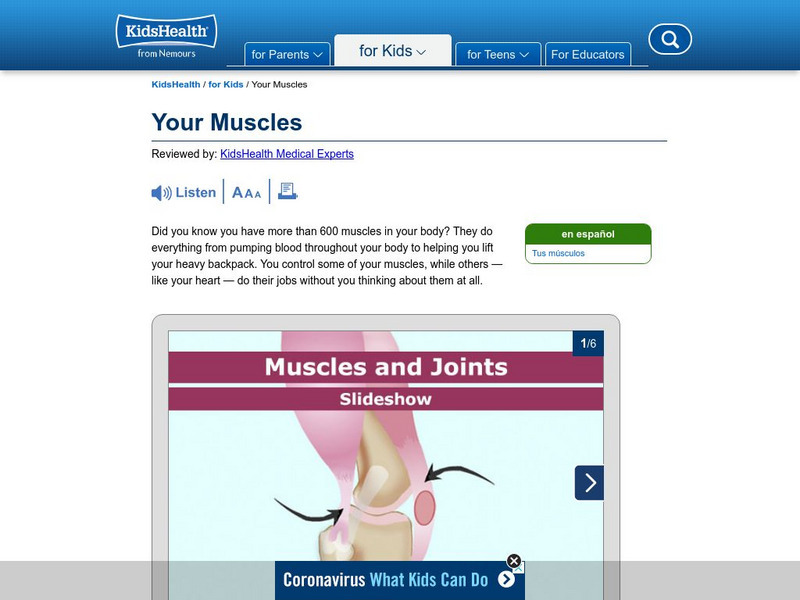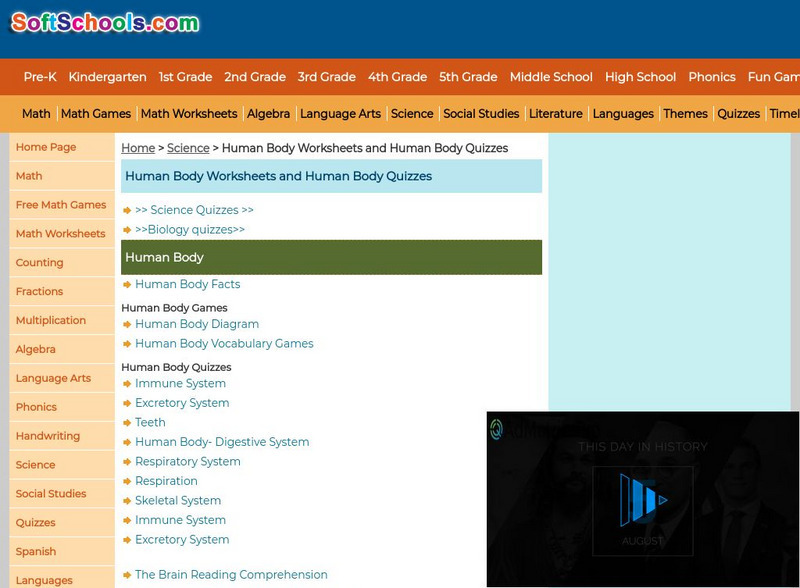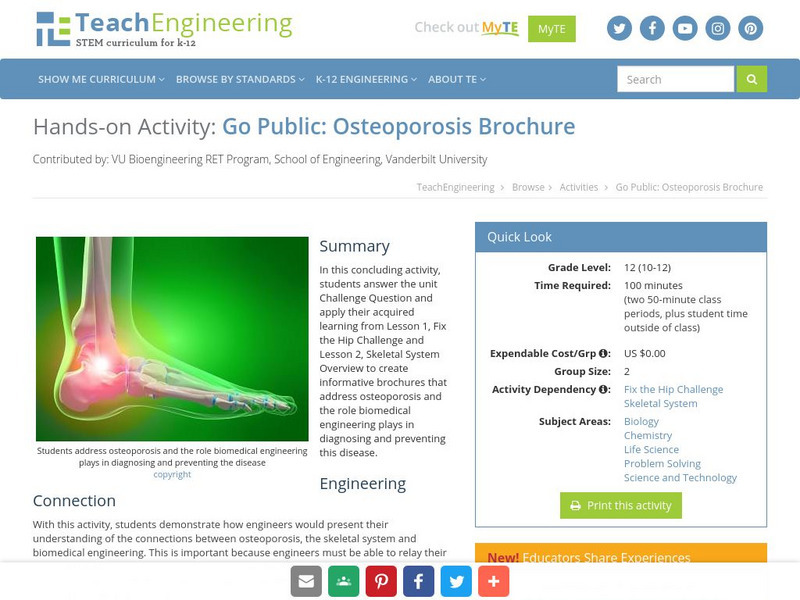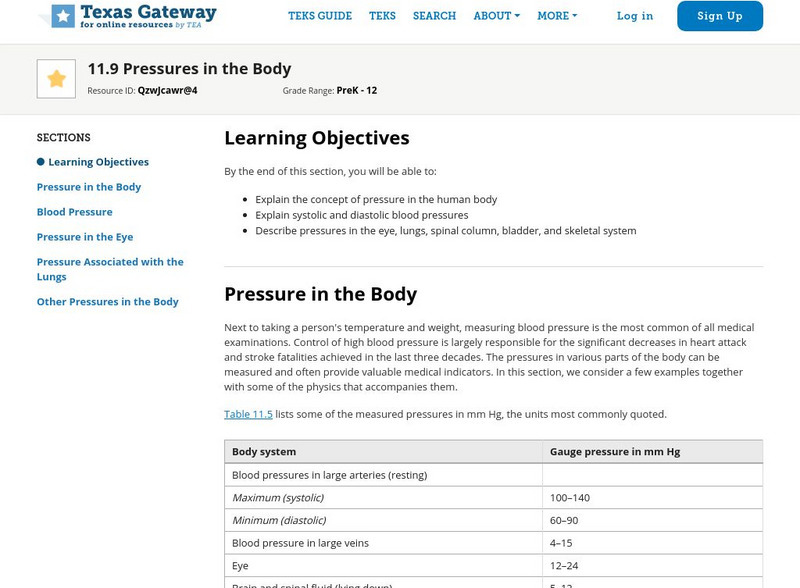Untamed Science
Untamed Science: Human Biology: Musculatory System
Learn about the three types of muscle tissue, how a muscle contracts, and how muscles are adapted for exercise. [3:40]
eSkeletons
E Skeletons: Human
Studying the skeletal parts of a human? Click on various parts of the human skeleton and proceed to select the items to view in detail.
eSkeletons
E Skeletons: Baboon
This interactive, digital laboratory provides students with a way to examine and learn about the skeletal anatomy of the Baboon.
eSkeletons
E Skeletons: Slow Loris
This digital laboratory provides an interactive environment in which to examine and learn about skeletal anatomy, in particular the skeleton of the slow loris.
eSkeletons
E Skeletons: Lesser Bushbaby
This digital laboratory provides an interactive environment in which to examine and learn about skeletal anatomy, in particular the skeleton of the lesser bushbaby.
eSkeletons
E Skeletons: Gibbon
This digital laboratory provides an interactive environment in which to examine and learn about skeletal anatomy, in particular the skeleton of the gibbon.
eSkeletons
E Skeletons: Orangutan
This digital laboratory provides an interactive environment in which to examine and learn about skeletal anatomy, in particular the skeleton of the orangutan.
eSkeletons
E Skeletons: Ruffed Lemur
This digital laboratory provides an interactive environment in which to examine and learn about skeletal anatomy, in particular the skeleton of the ruffed lemur.
OpenStax
Open Stax: Embryonic Development of the Axial Skeleton
The axial skeleton begins to form during early embryonic development. However, growth, remodeling, and ossification continue for several decades after birth before the adult skeleton is fully formed. Knowledge of the developmental...
National Institutes of Health
Nih Curriculum Supplement for Middle School: Looking Good, Feeling Good
A great resource from the Office of Science Education which provides a curriculum for teaching about the musculoskeletal system, the skin system and how they interact. This curriculum emphasizes choices teens can make to ensure good...
Curated OER
Kids Health: Bones, Muscles and Joints
The anatomy of the musculoskeletal system and what the bones, muscles and joints do in our bodies are explained. Interactive diagrams show the internal structure of a bone, and how muscles and joints work together. Major disorders of the...
Curated OER
Kids Health: Bones, Muscles, and Joints
This article from Family Doctor.org provides in depth terminology and helpful diagrams. This site has links to related articles to learn more about the musculoskeletal system.
Other
Nauticus: Bones an Exhibit Inside You: Skeletal Structure
A list of facts about the skeleton. Includes audio for hearing how to pronounce the names of bones, and links to a labeled drawing of the skeleton and to a bone facts quiz.
Curated OER
Kids Health: Your Multi Talented Muscles
At this site you will learn what muscles are made up of and find out about the different types of muscles in the body. A great illustration of a skeletal muscle is also provided. Available in Spanish.
BBC
Bbc: Applied Anatomy and Physiology: Muscles and Movement
Learn what muscles are, how they are classified, and how they are attached to the body's skeletal system. This site contains several definitions, illustrations showing the parts of muscles, and a quiz to test your knowledge of muscles...
Other
Cystic fibrosis.com: Reference Site
Cystic fibrosis is defined and a summary of its symptoms is provided. Includes an explanation of sweat tests, blood tests, and CF's effects on the digestive, respiratory, skeletal, and reproductive systems.
eSkeletons
E Skeletons: Tarsier
Examine the skeletal anatomy of the Tarsier's skull illustrated through the University of Texas at Austin's eSkeleton lab.
SEN Teacher
Sen Teacher: Label a Skeleton: Free Education Software
You can download free software here for Windows, Mac or Linux that presents the human skeleton, with or without flesh, with labeled skeletal parts. There is a quiz mode where students must match the labels to each bone as a timer goes.
Other
Biology Guide: Human Life Span
Students learn about the human life-span. Some topics investigated in the tutorial are reproduction, nervous system, skeletal muscle, and homeostasis.
Soft Schools
Soft Schools: Biology: Human Body Worksheets and Quizzes
Test your understanding of the human body and all of its complexities with these interactive worksheets, games and quizzes.
TeachEngineering
Teach Engineering: Go Public: Osteoporosis Brochure
Students will answer the Challenge Question and use the acquired learning from Lesson 1, "Fix the Hip Challenge" and Lesson 2, "Skeletal System Overview"to construct an informative brochure addressing osteoporosis and the role biomedical...
TeachEngineering
Teach Engineering: Forced to Fracture
Young scholars learn how forces affect the human skeletal system through fractures, and why certain bones are more likely to break than others depending on their design and use in the body. They learn how engineers and doctors...
Texas Education Agency
Texas Gateway: Fluid Statics: Pressures in the Body
By the end of this section, you will be able to explain the concept of pressure in the human body; explain systolic and diastolic blood pressures; and describe pressures in the eye, lungs, spinal column, bladder, and skeletal system.
Other popular searches
- Human Skeletal System
- Skeletal System Bones
- Skeletal System Experiment
- Animal Skeletal System
- Skeletal System Word Search
- Skeletal System Joints
- The Skeletal System
- Muscular Skeletal System
- Skeletal System Anatomy
- Skeletal System Lesson Plans
- Free Human Skeletal System
- Muscular and Skeletal System





















